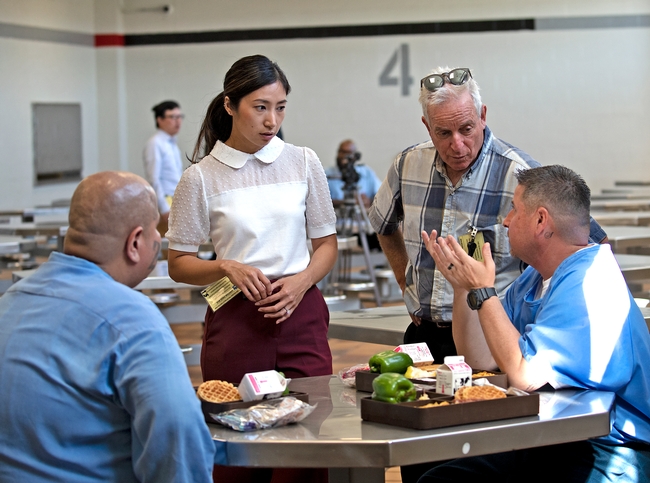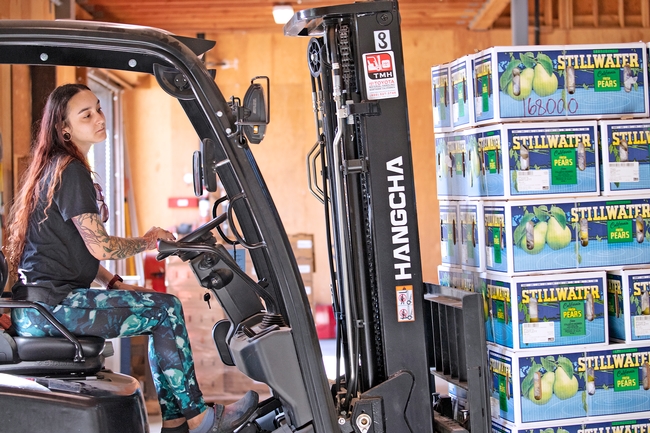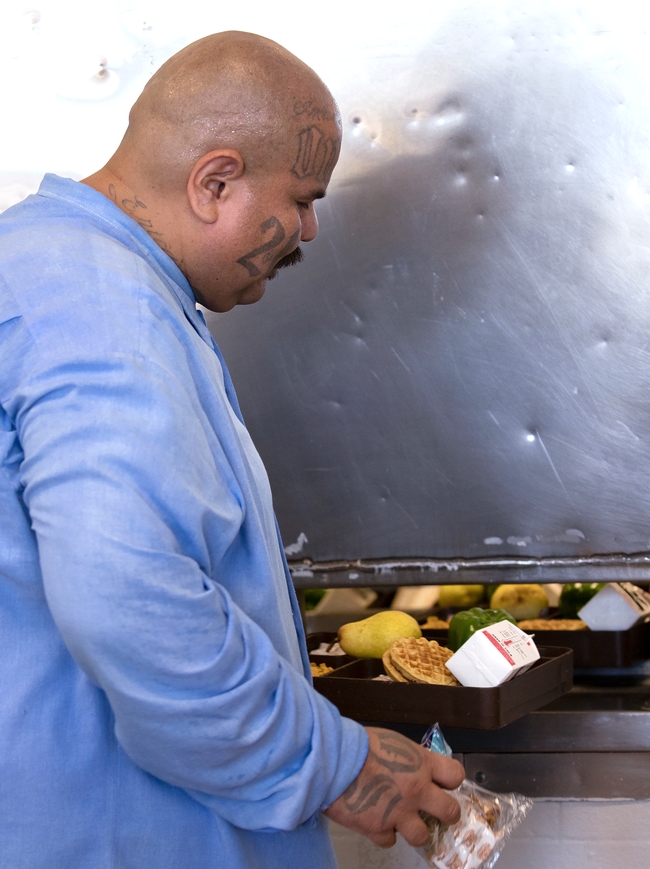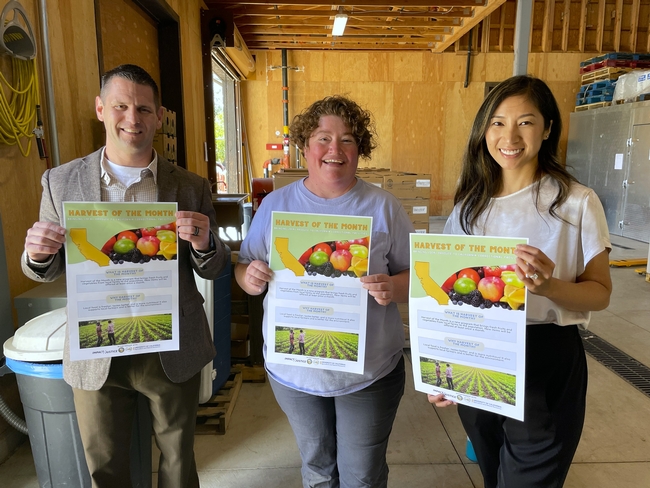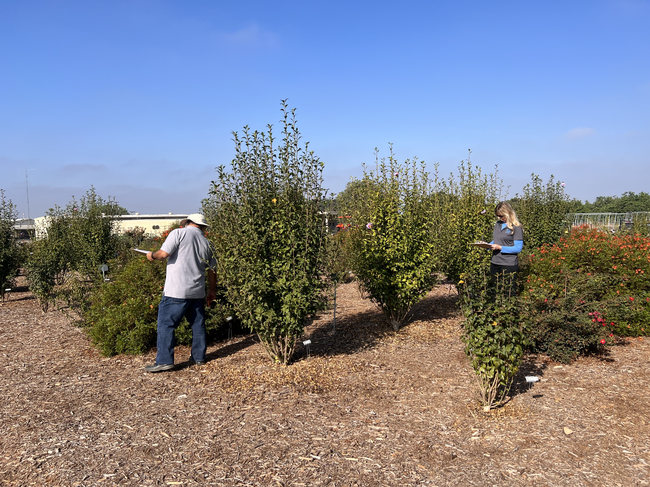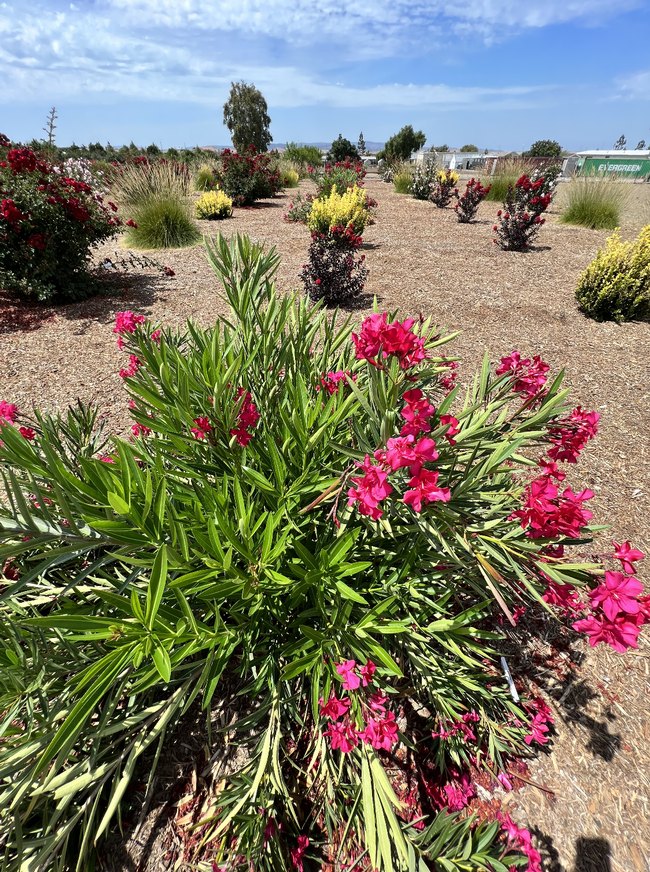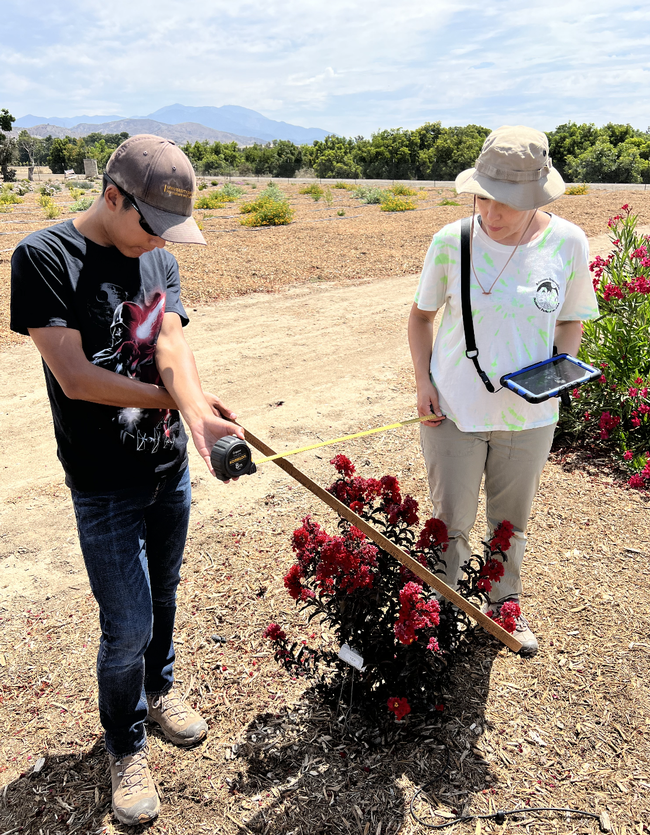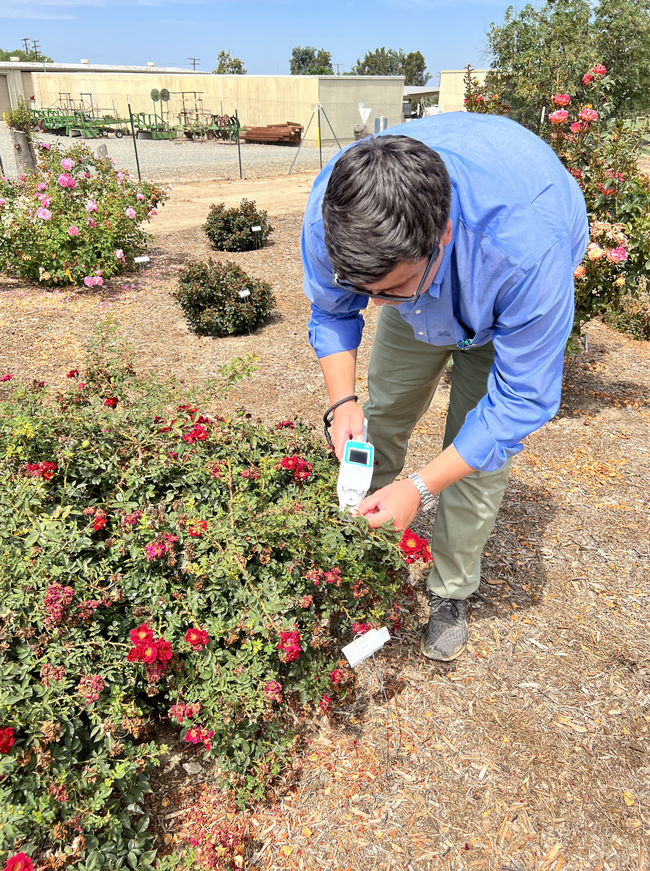Posts Tagged: Wendi Gosliner
Lawn-pocalypse! Surviving Drought
Ah, summer! The season of sunburns, pool parties, and… lawn droughts. If your once lush, green carpet now looks like a crunchy brown doormat, you're not alone. Let's dive into why your yard is staging a dramatic death scene and what you can do to...

Bermuda grass and weeds overtaking drought stressed turf grass.
‘Farm to corrections’ project provides fresh produce to people in prison, boosts California growers
Nutrition Policy Institute, Impact Justice, ChangeLab Solutions partner with California Department of Corrections and Rehabilitation
Serving slices of watermelon on the Fourth of July is a long-standing tradition at some facilities within the California Department of Corrections and Rehabilitation. But this July, there was something different about the watermelon offered to the approximately 8,000 residents at California State Prison Solano, California Medical Facility and Folsom State Prison.
It was juicy. It was sweet. It was “scrumdiddlyumptious,” according to one resident. And it was grown on a California family farm.
The three institutions are part of a “farm to corrections” project, Harvest of the Month, which aims to serve seasonal, locally grown produce to people who are incarcerated in California, while opening new opportunities for California farmers.
“We appreciate that someone cares enough to introduce this program that gives us something new,” said Jason Romero, a California State Prison Solano resident. “We look forward to what's coming in the future – California has the best stuff, right? – and hopefully we get other varieties of stuff.”
The program – bringing together the Nutrition Policy Institute, the nonprofit Impact Justice, and ChangeLab Solutions in collaboration with CDCR – was officially launched with the watermelon delivery in July. Pluots followed in August, and Bartlett pears were delivered in September.
“It's a ‘multiple wins' kind of an effort,” said Wendi Gosliner, the NPI principal investigator on the California Department of Food and Agriculture specialty crop block grant supporting the project. “The funding is available because the state is looking for state partners to purchase and expand the markets for California-grown fruits and vegetables. And we know that getting more of those fruits and vegetables on the plates of people who are incarcerated would be a huge bonus for them.”
California State Prison Solano resident Patrick Range said that, after tasting pluots for the first time through the program, the plum-apricot hybrid is now one of his favorites.
“I think I had five of them that day – and I'm waiting for them to have them again so I can get more; they were so good,” Range said. “It's something I'd never experienced, in the outside world or in prison.”
With rave reviews from residents and staff alike, CDCR – the State of California's biggest purchaser of food – is planning to roll out Harvest of the Month to all 33 of its adult facilities within the next two years.
“Food brings individuals together and introducing new products can give those in the care of CDCR something to talk about, as well as look forward to,” said Lance Eshelman, CDCR's departmental food administrator.
Improving conditions for people within correctional institutions is core to the mission of Impact Justice, which is working with partner organizations across the U.S. to bring fresher, more nutritious food to facilities, in support of residents' physical, mental and emotional health.
“We really want to prioritize the holistic well-being of an individual to help ensure that once they come home from incarceration, they are in a place where they are ready to actually contribute back to society,” said Heile Gantan, program associate with the Food in Prison project at Impact Justice.
Range said that enjoying the fresh produce – and learning more about its nutritional value – is helping him live a healthier, more energized, and hopefully longer life.
“I was a kid that didn't like vegetables; I didn't want nothing to do with vegetables…[but] as an adult, being 46 years of age, I want this for myself – I want to be able to tell someone else, to teach someone else about what I experienced when getting these fruits and vegetables that helped that nutritional factor,” he said.
In addition, Gosliner noted that early research suggests better food can benefit not only the well-being of residents but also of staff, with a calmer and safer work environment.
Partnership built on shared values, priorities
Gosliner and Ron Strochlic, academic coordinator at NPI, saw an opportunity to support “farm to corrections” work through a CDFA block grant, which aims to boost the purchase of California-grown specialty crops.
“CDCR is the state's largest single purchaser of food, so they're a natural place to consider ways to improve food systems,” said Gosliner, who was awarded the grant in 2020 to work with partners to research and develop pathways that encourage CDCR procurement of California produce, as well as nutrition programs for formerly incarcerated individuals. The project produced a report summarizing the opportunities and challenges in bringing more California-grown produce to the state's prison system.
The staff at Impact Justice appreciated that the NPI team brought not only research and evaluation acumen to the partnership but also an abiding concern for the people inside correctional facilities.
“Our grant funding was focused on simply increasing access to and consumption of California-grown specialty crops in CDCR prisons, but our team was very much in alignment around values and really focusing on the health and well-being of residents – highlighting and amplifying residents' experiences and voices,” said Leslie Soble, senior program manager of the Food in Prison Project.
Gantan echoed that sentiment, adding that NPI – which is under the University of California Agriculture and Natural Resources umbrella – also contributed its familiarity with regional food systems, particularly food hubs across the state.
According to the NPI team, engaging food hubs – organizations that aggregate, distribute and market food products from local producers – was a logical way to make a “farm to corrections” match.
“The majority of CDCR facilities are located in rural, agricultural regions, so to us, it was kind of a no-brainer to connect those facilities with the local communities and local farmers in the area,” Strochlic explained.
For the Harvest of the Month project, the partners teamed up with Spork, a Davis-based, mission-driven food hub that sources from growers across Northern California. Spork also aggregates the fresh produce from local farmers and delivers it to participating CDCR facilities each month.
“The farmers are very excited to see the change in the systems at CDCR in food and nutrition and what they're offering to the residents – and they're excited for the potential that this has for a larger, more consistent market,” said Hope Sippola, co-owner of Spork, which emphasizes working with underserved farmers as part of its mission. “We really needed to dig deep to figure out how to successfully implement this change of CDCR purchasing from large distributors to a food hub who sources from local family farms.”
Carolyn Chelius, an NPI project policy analyst and project manager of NPI's Farm-to-Corrections work, said the team hopes, as Harvest of the Month scales up, that they will be able to make Spork's generous investment of time and resources pay off.
“Our ultimate goal is to be able to benefit Spork and help them with their business, but it's been really helpful to have them as champions – people who are really interested in the mission,” Chelius said. “I don't know if this project would have been possible otherwise.”
California produce purchasing requirement helped spur project
Of course, cultivating a strong working relationship with CDCR also was essential. On the heels of AB 822 (a policy requiring state agencies to buy California-produced food over other options if the price differential is 5% or less), another powerful impetus for CDCR was the passage of AB 778 in 2022. It requires that, by the end of 2025, at least 60% of food purchased by state-run institutions must be grown or produced in California.
Eshelman, the departmental food administrator, said the law has challenged CDCR to look closely at its statewide menus and identify items that could be sourced from California growers and producers. He said that, through this project, food service team members have gained new knowledge about food production in the state, such as variability due to regional differences and weather trends.
“The Harvest of the Month program provides an additional resource, and places CDCR in contact with subject matter experts such as food hubs and local growers who can provide valuable insight into what to expect in terms of California-grown or produced food items and their accessibility,” Eshelman explained, adding that NPI and Impact Justice also have been vital resources for CDCR.
Gosliner acknowledges the challenges in retooling processes and procedures across CDCR, the second-largest correctional system in the U.S. With nearly 100,000 incarcerated individuals in its care, CDCR purchases more than $163 million in food each year.
“It's a big ask of a major state institution to reconsider some of their systems for doing something that they do every day: providing food to the people who are incarcerated,” Gosliner said. “It's revolutionary for them to rethink who they're sourcing from, to rethink how much fresh produce they're serving, to rethink the variety of that produce – it's a big lift for CDCR.”
‘This is really the beginning'
As CDCR brings Harvest of the Month to more institutions across the state, the collaborators anticipate that the logistics will smooth out – and that more farmers will be willing to participate.
“If we can add some more facilities and increase the volume, we have a better chance of making it work for growers, so we're really hoping that we can continue with this food hub model,” Strochlic said. “For us it's really important to be able to source from small and medium growers as well.”
And while flyers describing the health benefits of each month's “Harvest” item are currently distributed at the participating facilities, the partners hope they can provide additional nutrition education opportunities for the residents – during their time inside and after incarceration (like in the workshops held across the state).
Soble and Gantan of Impact Justice also noted that all members of the project team have been learning together, exploring “new territory” in growing this innovative partnership.
“I know personally I've learned so much from the NPI folks just about policy related to food and nutrition in California and about different nutrition interventions,” Soble said. “To me, it's been a very valuable and positive partnership.”
Gosliner said that building on those relationships will be crucial, as the movement to improve the services provided to incarcerated individuals continues to gain momentum in the state.
“This is really the beginning of California's work,” she said. “Even though we grow so much of the food here, there are other states in the country that are further along than we are in California. This is really the launch.”
Funding for this project was made possible by the U.S. Department of Agriculture's (USDA) Agricultural Marketing Service through grant AM200100XXXXG032. Its contents are solely the responsibility of the authors and do not necessarily represent the official views of the USDA.
Funds from UC Sustainable Agriculture Research and Education Program's Small Grants Program also helped support this project.
Climate-Change Resources
University of California UC ANR Green Blog (Climate Change and Other Topics) https://ucanr.edu/blogs/Green/index.cfm?tagname=climate%20change (full index)
Examples:
- Save Trees First: Tips to Keep Them Alive Under Drought https://ucanr.edu/b/~CdD
- Landscaping with Fire Exposure in Mind: https://ucanr.edu/b/~G4D
- Cities in California Inland Areas Must Make Street Tree Changes to adapt to Future Climate https://ucanr.edu/b/~oF7
Drought, Climate Change and California Water Management Ted Grantham, UC Cooperative Extension specialist (23 minutes) https://youtu.be/dlimj75Wn9Q
Climate Variability and Change: Trends and Impacts on CA Agriculture Tapan Pathak, UC Cooperative Extension specialist (24 minutes) https://youtu.be/bIHI0yqqQJc
California Institute for Water Resources (links to blogs, talks, podcasts, water experts, etc.) https://ciwr.ucanr.edu/California_Drought_Expertise/
UC ANR Wildfire Resources (publications, videos, etc.) https://ucanr.edu/News/For_the_media/Press_kits/Wildfire/ (main website)
-UC ANR Fire Resources and Information https://ucanr.edu/sites/fire/ (main website)
-Preparing Home Landscaping https://ucanr.edu/sites/fire/Prepare/Landscaping/
UC ANR Free Publications https://anrcatalog.ucanr.edu/ (main website)
- Benefits of Plants to Humans and Urban Ecosystems: https://anrcatalog.ucanr.edu/pdf/8726.pdf
-Keeping Plants Alive Under Drought and Water Restrictions (English version) https://anrcatalog.ucanr.edu/pdf/8553.pdf
(Spanish version) https://anrcatalog.ucanr.edu/pdf/8628.pdf
- Use of Graywater in Urban Landscapes https://anrcatalog.ucanr.edu/pdf/8536.pdf
- Sustainable Landscaping in California https://anrcatalog.ucanr.edu/pdf/8504.pdf
Other (Non-UC) Climate Change Resources
Urban Forests and Climate Change. Urban forests play an important role in climate change mitigation and adaptation. Active stewardship of a community's forestry assets can strengthen local resilience to climate change while creating more sustainable and desirable places to live. https://www.fs.usda.gov/ccrc/topics/urban-forests
Examining the Viability of Planting Trees to Mitigate Climate Change (plausible at the forest level) https://climate.nasa.gov/news/2927/examining-the-viability-of-planting-trees-to-help-mitigate-climate-change/
Reports and other information resources coordinated under the auspices of the United Nations and produced through the collaboration of thousands of international scientists to provide a clear and up to date view of the current state of scientific knowledge relevant to climate change. United Nations Climate Action
Scientific reports, programs, action movements and events related to climate change. National Center for Atmospheric Research (National Science Foundation)
Find useful reports, program information and other documents resulting from federally funded research and development into the behavior of the atmosphere and related physical, biological and social systems. Search and find climate data from prehistory through to an hour ago in the world's largest climate data archive. (Formerly the "Climatic Data Center") National Centers for Environmental Information (NOAA)
Think tank providing information, analysis, policy and solution development for addressing climate change and energy issues (formerly known as the: "Pew Center on Global Climate Change"). Center for Climate & Energy Solutions (C2ES)
Mapping Resilience: A Blueprint for Thriving in the Face of Climate Disaster. The Climate Adaptation Knowledge Exchange (CAKE) was launched in July 2010 and is managed by EcoAdapt, a non-profit with a singular mission: to create a robust future in the face of climate change by bringing together diverse players to reshape planning and management in response to rapid climate change. https://www.cakex.org/documents/mapping-resilience-blueprint-thriving-face-climate-disaster
Cal-Adapt provides a way to explore peer-reviewed data that portrays how climate change might affect California at the state and local level. We make this data available through downloads, visualizations, and the Cal-Adapt API for your research, outreach, and adaptation planning needs. Cal-Adapt is a collaboration between state agency funding programs, university and private sector researchers https://cal-adapt.org/
Find reports, maps, data and other resources produced through a confederation of the research arms of 13 Federal departments and agencies that carry out research and develop and maintain capabilities that support the Nation's response to global change. Global Change (U.S. Global Change Research Program)
The Pacific Institute is a global water think tank that combines science-based thought leadership with active outreach to influence local, national, and international efforts to develop sustainable water policies. https://pacinst.org/our-approach/
Making equity real in climate adaptation and community resilience policies and programs: a guidebook. https://greenlining.org/publications/2019/making-equity-real-in-climate-adaption-and-community-resilience-policies-and-programs-a-guidebook/
Quarterly CA Climate Updates and CA Drought Monitor Maps (updated each Thursday) https://www.drought.gov/documents/quarterly-climate-impacts-and-outlook-western-region-june-2022
Drought focus of Water Resources IMPACT magazine special issue
UC ANR experts address emotional toll of drought
Preparing the American West for prolonged drought is the focus of a double issue of Water Resources IMPACT magazine. The California Water Commission staff are guest editors for this special open-access edition of the magazine, which is published by the American Water Resources Association.
Faith Kearns, academic coordinator of University of California Agriculture and Natural Resources' California Institute for Water Resources, is among the authors delving into how drought impacts people and the environment and how we can better prepare for the inevitable.
The first issue, published on Feb. 14, focuses on water scarcity issues confronting California and the ways these issues affect different sectors.
In “Trauma, Care, and Solidarity: Addressing the Emotional Toll of Chronic Drought,” Kearns highlights the effects of drought on mental health. She points to the spike in suicide hotline calls when wells ran dry in Southeast Asian communities in California's Central Valley.
By listening to Southeast Asian farmers, Ruth Dahlquist-Willard and Michael Yang of UC Cooperative Extension were able to “lighten the load” for them by providing pragmatic support, Kearns writes.
“The scale of some of these highly emotional issues – drought, wildfires, climate change – can make them seem incredibly difficult, if not impossible, to deal with,” Kearns said. “At the same time, they are affecting everyone living in the western U.S. on a daily basis. I wanted to highlight and provide models based on work that people – whether they are researchers, clinical psychologists, or Cooperative Extension advisors – are doing right now to ease the way.”
The authors who contributed to the double issue are a diverse array of Tribal experts, academics, nongovernmental organization thought-leaders, water managers and water policy influencers, each of whom brings their own perspective on the topic of drought. Their expertise and perspectives in climate science, water policy and water management will help inform drought-related decision-making and support policies that better prepare the state to thrive during periods of prolonged water scarcity.
In addition to Kearns, the first issue includes articles contributed by:
- Samantha Stevenson, University of California, Santa Barbara
- Jay Lund, University of California, Davis
- Ron Goode, North Fork Mono Tribe
- Andy Fecko, Placer County Water Agency
- Jeff Mount, Public Policy Institute of California, and Ted Grantham, University of California, Berkeley/UC Cooperative Extension
- Nat Seavy and Karyn Stockdale, National Audubon Society
- Kjia Rivers, Community Water Center
- Cannon Michael, Bowles Farming
- Michelle Reimers, Turlock Irrigation District
The January/February edition of Water Resources IMPACT magazine can be accessed, free of charge, on the American Water Resources Association website at https://www.awra.org under “Publications.”
The second issue, to be published in March, will focus on drought response, considering the options for adaptation. This two-part series complements the Commission's work on strategies to protect communities and fish and wildlife in the event of a long-term drought.
Your water-efficient landscape doesn’t have to be barren
UC climate-ready landscape trials identify low-water yet attractive plants
Good news: roses can be a part of your water-efficient landscape. Lorence Oki, UC Cooperative Extension environmental horticulture specialist in the UC Davis Department of Plant Sciences, identified rose cultivars that remain aesthetically pleasing with little water.
Oki is the principal investigator of the Climate-Ready Landscape Plants project, which may be the largest irrigation trial in the western U.S., and the UC Plant Landscape Irrigation Trials (UCLPIT), the California component of that project. These projects evaluate landscape plants under varying irrigation levels to determine their optimal performance in regions requiring supplemental summer water.
“There are some assumptions that pretty plants use a lot of water, like roses,” Oki said. “Everyone thinks they need a lot of water, but we've found some that don't, and they still look great. A water-efficient landscape doesn't need to look like a Central Valley oak-grassland in the summer. It can look really attractive.”
In 2021, Oki's team at UC Davis identified Lomandra confertifolia ssp. pallida "Pom Pom" Shorty and Rosa "Sprogreatpink" Brick House® Pink as two of the best low-water plants in the trial.
“The useful tip or information that is shared at the end of each trial is the selection and designation of plants as Blue Ribbon winners. These are the plants that looked good with an overall rating of 4 or higher throughout and were on the low (20%) water treatment,” said Natalie Levy, associate specialist for water resources, who manages the project at the UC ANR South Coast Research and Extension Center.
How plants earn a blue ribbon
Each trial year, the selection of new plants is based on research recommendations and donated submissions from the nursery industry. The landscape plants are trialed in full sun or 50% shade cover.
Irrigation treatments are based on the rate of evaporation and plant transpiration (evapotranspiration) measured through a local California Irrigation Management Information System (CIMIS) weather station that provides a reference evapotranspiration (ETo) rate.
Three levels of irrigation are provided to the plants equal to 20%, 50%, and 80% of ETo. The volume of water applied is the same at each irrigation based on soil characteristics, but the interval between applications varies with weather and the treatment. Using this method, irrigations for the 20% treatment are less frequent than the 80% treatment.
“The 20% treatment during the 2022 trial was irrigated an average of once per month while the 80% treatment was irrigated weekly,” explained Levy.
During the deficit irrigation trial, monthly height and width measurements are taken to determine the plant growth index. Monthly qualitative aesthetic ratings on a scale of 1 to 5 are determined for foliage appearance, flowering abundance, pest tolerance, disease resistance, vigor and overall appearance.
A second round of flowering abundance and overall appearance measurements are also taken to capture more of the blooming period. For example, UCLPIT identified in the 2020 trial at South Coast REC that the "Apricot Drift" rose had a mean overall appearance score of 3.5 out of 5, deeming it “acceptable to very nice” and a low water use plant within the Water Use Classification of Landscape Species or WUCOLS guide.
Project expands options for landscape planting
“(WUCOLS) only has 3,500 plants in it. There are guesses that there are close to 10,000 cultivars in urban landscapes in California, if not more,” said Oki. “WUCOLS also didn't have numerical ratings. Instead, you'll see verbal ratings like ‘low water use' or ‘high water use.'”
The UCLPIT project has not only developed numerical recommendations for irrigation, but it has also added new landscape plants that are compliant with California's Model Water Efficient Landscape Ordinance. In fact, UCLPIT's data is one of the few sources that can be used to supplement WUCOLS.
Geographic diversity of trial sites adds to knowledge base
In addition to UC Davis and South Coast REC in Irvine, the trials have expanded beyond California as the Climate-Ready Landscape Plants project and is in progress at Oregon State University, University of Washington, University of Arizona and Utah State University thanks to a USDA/CDFA grant awarded in 2020.
Lloyd Nackley, associate professor of nursery production and greenhouse management at Oregon State University, is the principal investigator of the trial in the Portland metro area, which is entering its third year.
“People know that there are drought tolerant plants, but there are many. We're trying to highlight lesser known or newer varieties. And even though the trial is three years, most gardeners would hope that their garden lasts longer than that,” said Nackley.
One of the observations that Nackley recalls is of the Hibiscus Purple Pillar plant. Unlike the trial at South Coast, the Purple Pillar did not perform well in Oregon in the spring.
“It wasn't until August that we saw the plant bloom and begin to look like what we saw from South Coast in April,” Nackley said.
Ursula Schuch, horticulture professor and principal investigator of the trial taking place at the University of Arizona, was also surprised at the range of performance among different plant types and the effects of irrigation, heat and temperature.
“This research will reassure green industry professionals that they can stretch their water budget to successfully cultivate more plants, watering them according to their needs instead of irrigating every plant according to the highest water-using plants,” said Schuch.
Although research is only conducted in the West, the hope is that there will be trials in other regions of U.S.
Doing so would yield comprehensive information about the plants and their performance in different climates. As extreme weather events persist in the U.S., disease pressure and risks do too. Trials throughout the country would provide location-specific data regarding disease susceptibility.
To learn more about the UCLPIT research project, visit https://ucanr.edu/sites/UCLPIT/



